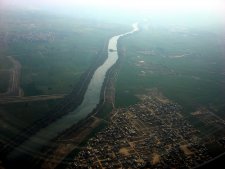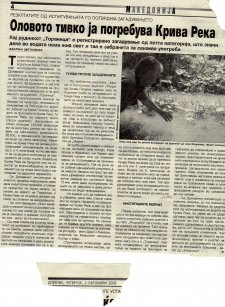By Seema Kumar (Posted: October 30, 2008)
The Environmental Impact Assessment Notification of 2006 (amended in July 2004 to incorporate new and expansion/modernization projects; originally enacted in 1994) under the Environment (Protection) Act of 1986 requires that a scheduled list of projects and activities must provide for public consultations and receive prior environmental clearances from the Ministry of Environment and Forests (MoEF), the environmental arm of India’s Central Government. However, there are blatant loopholes in this spineless attempt to prioritize the welfare of the environment over the continuous blossom of construction for the sake of economic development.
It has been cited in several case studies that the Yamuna River suffers from severe anthropogenic pressures, such as civic construction, alteration in landscape pollution, change in nature of vegetation, and over-exploitation of species and agriculture, which has severely diminished the river’s capacity to be a reliable source for drinking or agricultural purposes. Increasing levels of urban runoff and sewage from Delhi’s booming population contribute to Yamuna’s polluted waters and flood phenomenon, and the Yamuna floodplains are struggling to recharge its groundwater resources. Thus, it has been strongly recommended to halt civic construction in the vicinity of the river and suspend the channelization of its water, as such actions could prove fatal in the river’s ability recharge itself of its groundwater supply.
This brief note will illustrate how effortless it is for project proponents to exempt themselves from obtaining environmental clearances and holding public consultations through the lens of two development projects upon the Yamuna River (a 22km stretch of the river that flows through Delhi’s eastern border), i.e. the Delhi Metro Rail Corporation Ltd. and the Commonwealth Games Village.
Delhi Metro Rail Corporation Ltd. (DMRC)
Phase II of the DMRC project involves the construction of several railways that will, upon completion in 2011, connect Delhi and the immediate regions outside of its territory. One particular railway traverses over the Yamuna River, in addition to the construction of a Depot that would sit upon the banks of the Yamuna. The DMRC contracted with a consultancy organization called RITES to conduct the EIA study. RITES is a Government of India Enterprise, established under the aegis of Indian Railways. In 2004, RITES, to no shock, concluded that since railway (urban transportation) projects are not specified in the scheduled list of projects requiring environmental clearances, an environmental clearance and public consultations are not mandated in order to proceed construction. While public transport is a cleaner, efficient development strategy, its environmental impact must be taken into consideration.
Commonwealth Games Village (CGV)
In 2010, Delhi will host the Commonwealth Games that are held every four years in one of 53 Commonwealth countries. In preparation for the Games, the Delhi Development Authority (DDA) granted a Dubai-based real estate developer, EMAAR, the bid to construct a, 63.5 hectare, residential and commercial complex to accommodate visiting athletes and gaming officials on the Yamuna River floodplain. DDA, created under the Delhi Development Act of 1957, possesses the power to acquire, hold, manage, and dispose of land to promote and secure the development of Delhi.
In 1998/’99, the National Environmental Engineering Research Institute (NEERI) was commissioned by the DDA to prepare an Environmental Management Plan with the overall objective of rejuvenating the Yamuna River. NEERI’s ’98/’99 report suggested that recreational areas and camping sites should not be allowed to interfere with the floodplains. At this time in EIA history, it was not necessary for the DDA to obtain an environmental clearance for the CGV structure, as the schedule list had not been amended to include new construction and buildings.
Fearing the CGV structure would be considered a recreational construction, in 2005, NEERI was commissioned again to submit a similar report to the DDA on the Yamuna River. This time, the report expressly prohibited residential and industrial facilities requiring permanent structures on its riverbed. It is important to note that the DDA now needed an environmental clearance for the construction of the CGV because of the 2004 EIA Notification amendment. However, the DDA concealed this 2005 report from the MoEF until 2006, which lead to the Expert Appraisal Committee (EAC) of the MoEF, the committee that appraises EIA proposals, recommending another study be conducted on this issue by the Central Water and Power Research Station, Pune (CWPRS), a R&D organization, affiliated with the Ministry of Water Resources, Government of India.
Meantime in late 2006, the MoEF granted an environmental clearance for the CGV structure on the condition that it would not be permanent in nature. In early 2007, the CWPRS report was submitted, and based on its findings, the 2006 environmental clearance was ‘renegotiated’ between the MoEF and the DDA to essentially allow permanent structures in the Yamuna riverbed.
In January 2008, a court visit was made to the site in dispute, and immediately following this site visit, the Ministry of Science and Technology (NEERI is apart of this Minstry) and the DDA coerced NEERI to publish a report to appease the court, which concluded that a man-made bund type structure around the project would shield itself from affecting the floodplain.
It is imperative to note that not once during this entire EIA process were public consultations sought or mandated by the EIA Notification Process.
Recommendations
Based on the DMRC and CGV development projects, there are two recommendations that, if adopted, would add integrity and transparency to the EIA process (There are several other recommendations to be made – these are specific to the above examples).
First, an Independent Oversight Committee should be established as the binding authority over the MoEF. As it presently stands, the MoEF can be easily threatened by government pressure and seek out loopholes to grant environmental clearances. The EIA process should be free from political agendas and manipulative gestures and instead concentrate on the task it was enacted to do. This Committee should be comprised of environmentalists, scientific experts, construction experts who can ascertain the actual damage of development projects, representatives from tribal and/or rural communities (who are most affected by development projects because their land is resource rich), and public interest organizations who have a record of providing unbiased factual information. The Oversight Committee, by assessing MoEF grants and having the power to override the MoEF’s decision, can ensure the public that environmental clearances are granted as a result of diligent appraisal as opposed to business-as-usual tactics.
Second, public consultations should be required for all development projects and occur at various stages of the EIA process. Under the current EIA Notification, several projects, such as mining projects, modernization of existing irrigation projects, projects located in designated as special economic zones and industrial estates/townships, are exempt from public consultations. Many projects, therefore, are strategically labeled as one of the allowed exemptions to avoid public participation. Such exemptions should be eradicated from the EIA Notification, and it should be mandatory that all projects be subject to public consultations.
In addition, public consultations should be conducted at intervals during the EIA process and not simply after the EIA Report has been prepared. Public consultations should also be held after scoping and assessment of alternative sites and after impact predictions and mitigation measures have been considered to allow the public to understand and raise educated concerns throughout the EIA process. As the procedure exists now, the public consultation is a formality without any bearing on the outcome of environmental clearances. The public receives only one limited opportunity to convene to ask questions and assert their positions. Often times, they are overwhelmed with details and do not have enough background information about the project for the hearing to be meaningful.
Conclusion
The public is distrustful of the Indian government’s environmental protection commitments and rightfully so, as their concerns are secondary to economic development. The DMRC and CGV are only two of the countless examples of where the environment has lost its battle for survival because the environmental evaluation process is slanted toward private interests. In order for the EIA Notification to become a reliable act of government, substantial reformations will have to be made.




